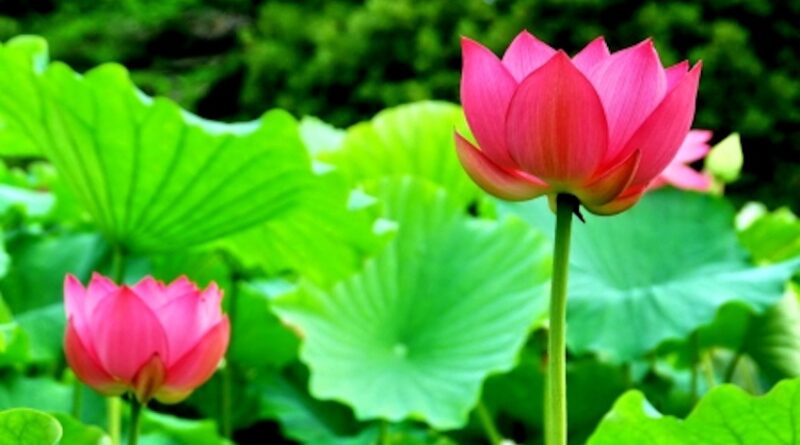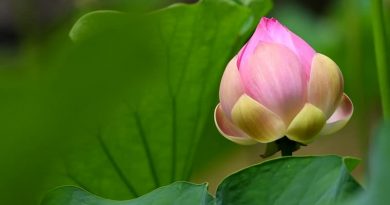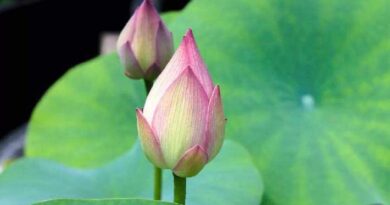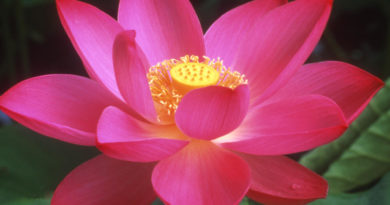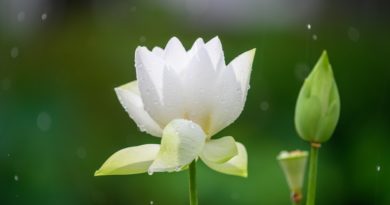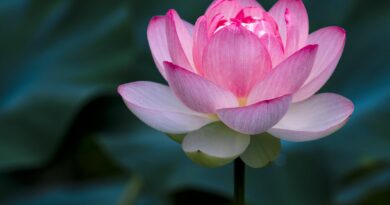A DISCOURSE ON MALUKYAPUTTA SUTTA – VIPASSANA QUESTION V
A DISCOURSE ON MALUKYAPUTTA SUTTA – VIPASSANA QUESTION V
The fifth question put to Malukyaputta is as follows.
“Ye te kayavinneyya photthabba asamphuttha asamphutthapubba, na ca phusasi, na ca te hoti phuseyyanti, atthi te tattha chando va rago va pemam va.”
“How do you answer this, Malukyaputta? Answer me as best you can. There are certain tangible objects which you have never touched previously, either in the immediate or remote past, or at the present moment. Neither can you hope to touch them in the future. Can such objects arouse desire, lust and affection in you?”
Malukyaputta replied this in the negative. This is as it should be. Here it may again be emphasised that no //kilesa// can arise for sense-objects with which one is not familiar. Indigenous peoples develop no taste for foreign-made dresses which they have never seen before. The same analogy applies to friendship — one never makes friends with people whom one has never met or seen before.
For most of us seeing or hearing is generally infrequent. We are not seeing or hearing things all the time. Since we are not occupied with eating all the time, tasting is also less frequent. Tactile sensations however, occur every now and then. They are far more prominent than other sensations. They may be felt even when one is sitting or standing still, or when eating or drinking. So we are always involved with contact, day in and day out. When yogis meditate, they usually meditate more on contact than on any other sense-objects.
The Text says: //Gacchanto va gacchamiti pajanati// — Know that you are going when you go. When you note the act of walking — extending legs, raising them up and putting them down, you are conscious of the entire movement connected with the process of walking. That means to say that the knowledge of walking has arisen, in which case let that knowledge remain as it is according to the instruction: //Mute mutamattam bhavissati// — When you know, let that knowing be. Do not go any further than that. This meditation is on the activities of //vayo//, element of motion, although at times //tejo//, element of heat and //pathavi//, element of hardness, may get automatically involved. But what is to be concentrated upon is //vayo//.
The Text further goes on to say: //Thito va thitomhiti pajanati; nisinno va nisinnomhiti pajanati — Know that you are standing when you stand. Know that you are sitting when you sit. Here, too, you are being instructed to note the nature of //vayo//.
If you are not satisfied with this method, note the activity of //vayo// by watching the rise and fall of the belly as you are standing, sitting or lying down.
WHY MINDFULNESS ON RESPIRATION IS NOT SUGGESTED
In the ten //anussatis// or recollections, //anapanasati//, concentration on respiration, is included. It is concentration on breathing in and breathing out. Breathing is an act of //vayo//. It may now be asked why I do not make any suggestion to take up the exercise of breathing in and out. In my own opinion, I agree that //anapana// method could lead to the establishment of //vipassana nana//. But it must be noted that Visuddhi Magga puts it in the category of //samatha//, concentration, as distinct from //vipassana//, insight-meditation, when it enumerates the 14 //kayanupassanas//, mindfulness of the physical body as follows:
“The three chapters relating to the four postures, the four factors of knowledge and the four methods of fixing the mind on //dhatu//, primary elements, are said to fall under the category of //vipassana//, insight-meditation….Whereas the two chapters dealing with mindfulness on respiration and fixing the mind on loathsomeness of the physical body are said to fall under the category of //samatha//, concentration.”
Thus it has been clearly and unequivocally stated that //anapana// belongs to //samadhi bhavana//, development of concentration, //samadhi kammatthana//, exercises in concentration. Therefore, if we advocate breathing exercises we would certainly be open to criticism that we are teaching not //vipassana// but //samatha kammatthana//, in which case we will be unable to make a rebuttal of the charge made without going against the teaching of Visuddhi Magga. But we allow those who would like to take up mindfulness on respiration to have their wish. We impose no restrictions on them.
Patisambhida Magga and Visuddhi Magga are explicit on the point that, when doing breathing exercises, one must concentrate his mind on the nose without letting the mind follow the course of the stream of air breathed in. The object is to enable the meditator to develop //upacara samadhi//, approximate concentration, and //appana samadhi//, ecstatic concentration, to become enrapt in //jhana//. In the practice of insight-meditation, there is no restriction that directs the meditator to note only one phenomenon at a stretch. But if we instruct the meditator to note all the phenomena of contact that take place in various parts of the body while breathing in and out, we will again be open to the criticism that we are going against the two authorities that I have cited. These are the reasons why we refrain from encouraging meditators to indulge in //anapana// for insight-meditation.
MEDITATION ON ABDOMINAL MOVEMENTS CONFORMS TO CANONICAL INSTRUCTIONS
It has been questioned if instructions to meditate on the rising and falling of the abdomen really conform to the requirements of the Pali Canon. It may be answered in the affirmative on the authority of Sallayatana Vagga Samyutta where it is stated that failure to note the arising and passing away of //nama// and //rupa// that come up at the six sense-doors results in the upsurgence of //kilesa//, while meditating on them brings Nibbana closer through the realization of the Path and its Fruition with the suppression of //kilesa//. The present Malukyaputta which I am discussing is also very clear on this point. I shall give reasons in support of the conformity.
When Satipatthana teaching prescribes observing the four //dhatus//, it is advocating the observance of the apparent phenomena created by the four primary elements. Abdominal movements indicate the working of //vayo// to note which one fixes one’s mind on one of the //dhatus// conforming to the requirement of //dhatu manasikara//. I prefer using ordinary language to highly technical Pali terms; and so, instead of saying //vayo dhatu//, I say the rising and falling movements of the abdomen. My employment of the ordinary conversational language agrees with Buddha’s preference to simple speech when he gave the advice: //Gacchamiti pajanati//. As the yogi’s concentration gets strong with the continued practice of insight-meditation, he will come to realize the nature of the element of motion represented by movements of the abdomen.
On the authority of Satipatthana Sutta and other Suttas in Samyutta Nikaya, we also take it that a meditator should concentrate not only on the four postures usually mentioned in the scriptures but also on other postures or physical behaviour that can be met with in the ordinary course of nature.
If a yogi does not feel satisfied with noting the rising and falling of the abdomen, he can try with meditating on sitting as he sits, or on standing as he stands, or no lying down as he lies down. But we do not insist a yogi to practise //anapana// as we hold that it goes against statements in Visuddhi Magga and Commentaries on Satipatthana Sutta, which speak of insight-meditation after the attainment to the state of //jhana// through noting breathing in and breathing out. But we do not deter anybody from practising //anapana//. Now I shall revert to my original theme.
FAILURE TO MEDITATE ON PHASSA ON TOUCHING
- Phassam phussa sati muttha, Piyam nimittam manasi karoto. Sarattacitto vedeti, tanca ajjhosa titthati.
- Having touched //phassa//, tangible object, one loses mindfulness, and getting absorbed in the charms created by it, one feels the onset of desire that tries to imbibe it.
Tactile sensations arise everywhere in the physical body. When a living body touches an inanimate object, such sensations arise. When limbs of the body touch one another, the same thing happens. Those are external sensations of touch. Likewise there are internal sensations which usually pass our notice. For instance, we are unaware of the fact that blood comes into contact with muscular tissues imbedded in the body. Those not used to the practice of //satipatthana// cannot take full note of the external senses of touch, let alone the internal. So when you practise meditation loosely, you are liable to be forgetful of the dhamma although you will be remembering the beautiful when you see beauty. It is human nature to hanker after pleasurable sense-objects; and when they are discovered you forget to note the arising and passing away of the aggregates. At times you may feel repugnant to disagreeable sights you see or disturbing sounds you hear. This also makes you to be forgetful of the dhamma.
The five constituents of pleasure invite //kilesa// for all unmindful persons. Our way of living is one of enjoyment of pleasure. When we sleep on soft beds we are pleased with the comfort it gives. Latest fashions in dress give us a feeling of luxury. Even when we are doing the daily constitutional for health we are prone to get delighted with the thought that it is contributing to our body beautiful. All these delights and pleasures are a product of our surroundings which almost worship the five constituents of the senses. They generate //kilesa//. Nibbana remains far removed from those with a mind of defilements. Hence the following stanza.
- Tassa vaddhunti vedana, aneka phassasambhava; Abhijjha ca vihesa ca, cittamassupahannati. Evam acinato dukkham, ara nibbana vuccati.
- A multitude of passions such as covetousness and rage, springing from //phassa//, contact, torments him who takes a firm hold of it, with the consequence that his mind becomes burdened with vexation. Nibbana, therefore, remains far away from him who would carry the load of suffering rather than meditate.
All that have been said about seeing, hearing, etc. apply to touching. What may be emphasised as usual is the fact that bowing to the wishes of //kilesa// one accumulates the mass of suffering which keeps one away from the path to Nibbana.
MEDITATION ON PHASSA BRINGS NIBBANA NEAR
- Na so rajjati phassesu, phassam phussa patissato; Virattacitto vedeti, tanca najjhosa titthati.
- Passion remains undeveloped in him who recollects with mindfulness //phassa//, contact, that he has experienced. Thus freed from lust, he refuses to imbibe it.
In the course of meditating on the phenomenon of standing a yogi may feel tired or stuffy or painful or itchy. These are unpleasant sensations called //dukkha vedanas//. When they appear you must concentrate on the source of uncomfortableness and note in your mind the nature of tiredness or pain etc. As this constitutes meditating on //dukkha vedana//, this method is called //vedananupassana//. When you note heat that is generated, you meditate on //tejo//; and when you feel that you are touching a hard and rough surface, you meditate on //pathavi//. At times you may feel that the element of motion gets merged with the element of heat. You note this also and meditate on it. You may note every physical behaviour that occurs. You may bend or stretch your arms and legs. You may throw your head backwards and forwards. You may shut or open your eyes. You may wink. You may indulge in various kinds of movements as you dress, or as you wash your face, or as you take a bath. Even when you are urinating or evacuating your bowels, you must not forget to note the manifestation of //vayo//. With practice you may be able to note even speaking as you speak.
Our injunction to note the rise and fall of the belly is for the benefit of beginners in meditation. If he likes he can take up noting the respiration. But in our experience we have come to know that some who began the practice of breathing in and out endedup with meditating on the rise and fall of the belly, and that they did realize the dhamma. We used to instruct the yogi whose powers of concentration have strengthened to extend his method of meditation to noting all that happens at his six sense-doors.
When //raga// is abandoned through the practice of mindfulness, you will have no desire to grab //photthapha//, tactile sensation, and swallow it up.
- Yathassa phusato phassam, sevato capi vedanam; Khiyati nopaciyati, evam so caratissato. Evam apacinato dukkham, santike nibbana vuccati.
- On contact with a tangible object, a yogi just touches it and just gets the feeling of touch without assimilating //phassa//, created by the touch. With him suffering ceases. He should practise meditation in this way; and if he so practises it, he is said to be within sight of Nibbana.
What has been discussed in the foregoing relating to other senses applies in the present case.
NEGATION OF CORRECT METHOD
Among us there are some dissidents who neither practise the dhamma nor accommodate others practising it. They reject the methods relating to meditation saying that as everybody has been aware of his own physical behaviour, it is unnecessary for him to note with mindfulness.
The purpose of meditation is to prevent //kilesa// from arising from the time consciousness occurs in relation to sense-objects that actually come into contact with the sense-base. Meditation on things which have never been seen or heard is excluded. Dissidents, in their attempts to pass strictures on our method of teaching, maintain that noting the rise and fall of the belly is superfluous. This goes against what is prescribed in Malukyaputta Sutta or Maha Satipatthana Sutta. Everybody is aware that he breathes. It would be preposterous to say that he should be made to be unaware of his own breathing.
Those who put forward the proposition that one should not meditate on this physical body or parts of it such as head, limbs, abdomen are going dead against Buddha’s teaching. Perhaps they do so because they have never experienced insight knowledge. When you see and note //rupa// reflected by your own body, it perfectly accords with the instruction: //Rupam disva patissato// — Note //rupa// when you see it. In the same way you must meditate on contact in accordance with the instruction: //Phassam phussa patissato// — Note contact when you touch. There is nothing in the Pali Canon and their Commentaries to suggest that anyone is to be deterred from noting his physical behaviour. All sense-bases, sense-objects and sense-consciousness originate in the body, and if we are to be prevented from noting them, it will go against the teaching. Those who advocate such ideas are preaching adhamma.
I give below the method of insight-meditation in brief:
Note every time //rupa// and //nama// arise. This will lead you to gaining knowledge about their causes and effects. In the end you will recognize the Three Marks of //anicca//, impermanence, //dukkha//, suffering or unsatisfactoriness, and //anatta//, unsubstantiality. He who practises in this manner can enter Nibbana.
Now I shall give you the task laid down by Buddha regarding meditation on mind-objects that cause mind-consciousness to arise.

